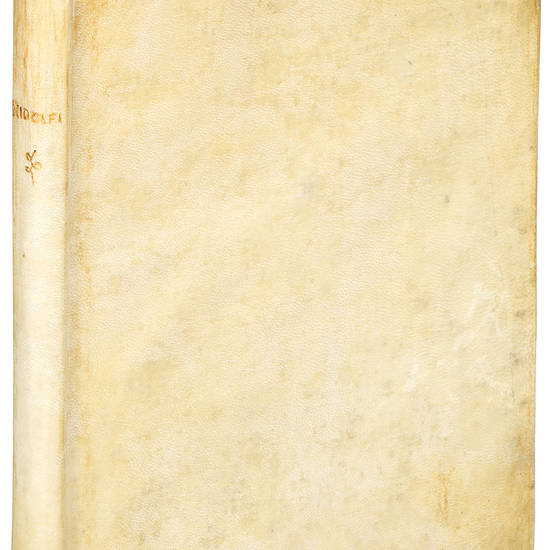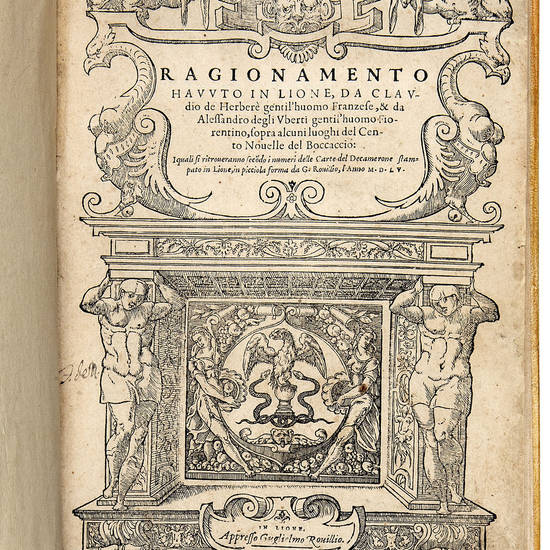Ragionamento havuto in Lione, da Claudio de Herberè gentil’huomo franzese, et da Alessandro degli Uberti gentil’huomo fiorentino, sopra alcuni luoghi del Cento novelle di Boccaccio, i quali si ritroveranno secondo i numeri delle carte del Decamerone stampato in Lione, in picciola forma da G. Rovillo
Autore: RIDOLFI, Luca Antonio (1510-1570)
Tipografo: Guillaume Rouillé
Dati tipografici: Lyon, 1557
4to (215x151 mm). 100, [2] pp. Collation: A-N4. Lacking the final blank. Errata on l. N3r. Title page with an elaborate woodcut border and Rouillé's device at the centre. Modern flexible vellum with inked title on spine. Slightly browned, upper and lower margins of the title page and last leaf reinforced, three small holes on the errata leaf affecting one letter, a good copy.
RARE FIRST EDITION (the book was reprinted in 1558 and in 1560). Over his career, the publisher, Guillaume Rouillé (c. 1518-1588), starting with an Italian translation of De viris illustribus urbis Romae, published over seventy books in Italian in Lyons. These were addressed not only to the Italians residing in France, but also to the many French men and women who had learned Italian in the course of war, study, or business. Rouillé had learned the book business in Venice with Giovanni and Gabriello Giolito and established himself in Lyons in 1543. His book production exceeded that of Robert Estienne, Gryphius and de Tournes, and his learning at least equalled their own. His firm gained a European reputation and his books were also sold in Antwerp, Frankfurt, Medina del Campo, and Saragossa, as well as in Venice and Naples (cf. N. Zemon Davis, Publisher Guillaume Rouillé, Businessman and Humanist, in: “Editing Sixteenth Century Texts. Papers given at the Editorial Conference University of Toronto”, R.J. Schoeck, ed., Toronto, 1966, pp. 72-112; see also J. Balsamo, L'italianisme lyonnais et l'illustration de la langue française, in: “Lyon et l'illustration de la langue française à la Renaissance”, Lyons, 2003, pp. 211-229).
Rouillé dedicated his Decamerone to Marguerite du Bourg, Dame du Cange, wife of a high-ranking French financial officer and a very learned woman, to whom he would also later dedicate his 1558 edition of Petrarch (cf. M.-M. Fontaine, ‘Un couer mis en gage'. Pontus de Tyard, Marguerite du Bourg et le milieu lyonnais des années 1550, in: “Nouvelle Revue du XVIe siècle”, 1984/2, p. 76-77).
Lucantonio Ridolfi collaborated with Rouillé on the edition of Petrarch and Boccaccio and published, at his press, the dialogue Aretefila (1560). As may be surmised by the title, the Ragionamento is intended as a page-by-page commentary on Rouillé's edition of the Decamerone. “Le text est anonyme, mais il est sûrement de Ridolfi, ainsi qu'en témoigne une lettre de son ami Alfonso Cambi. Herberé est un Français féru d'italien, qui a été inspiré par un séjour de deux ans dans le cercle de Marguerite de Berry, où tous cultivent le toscan. Herberé cherche à perfectionner son italien à l'aide du Décaméron, et se met à interroger Degli Uberti sur le text. Ce Degli Uberti est basé probablement sur quelque parent d'Antonio di Niccolò degli Uberti, éditeur du Décaméron en 1527, mais ce qu'il dit reflète les opinions de Ridolfi lui-même, qui n'oublie pas quelques allusions désobligeantes sur d'autres éditeurs, dont Girolamo Ruscelli (Venise 1552). Ces allusions valurent à Ridolfi quelques médisances de la part d'autres exilés florentins, dont Ludovico Castelvetro dans une lettre à Francsco Giuntini. Mais l'intérêt du dialogue réside dans ce qu'il nous apprend sur la fortune en France de Boccace, ainse que dans les multiples allusions dans le text à la Divina Commedia” (R. Cooper, Le cercle de Lucantonio Ridolfi, in: “L'émergence littéraire des femmes à Lyon à la Renaissance, 1520-1560”, M. Clément & J. Icadorna, eds., Saint-Étienne, 2008, p. 43).
“Lucantonio Ridolfi publie également chez Guillaume Rouillé des dialogues qui mettent en scène une société franco-italienne, riche de débats. Tel est le cas de celui qui oppose un Français (Claude de Herberay) et un Florentin (Alessandro degli Uberti) discutant du Decamerone de Boccacce et de questions linguistiques à propos des trois auteurs canoniques, Dante, Pétrarque et Boccacce, et qu'il rapporte dans le Ragionamento havuto in Lione, da Claudio de Herberè gentil'huomo franzese, et da Alessandro degli Uberti gentil'huomo fiorentino, sopra alcuni luoghi del Cento novelle di Boccaccio (1557)” (M. Huchon, Louise Labbé. Une créature de papier, Genève, 2006, p. 42).
Luc'Antonio Ridolfi was born in Florence, where he also received his early education. He settled in Rome in the early 1530s and became known in the literary circles of that city. After the murder of Alessandro de' Medici he took refuge in Lyon, as did many of his ‘Republican' compatriots, but maintained close ties with many of the Florentines who remained in Italy, such as Claudio Tolomei, Niccolò Martelli, Pietro Vettori and Benedetto Varchi. He had arrived in Lyon as a merchant, but around 1542 he began to work for the printing house of Gauillaume Rouillé as editor and translator of Italian texts. He spent the last years of his life in Florence (cf. E. Guidici, Luc'Antonio Ridolfi et la Renaissance franco-italienne, in: “Quaderni di filologia e lingue romanze”, n.s. 1, 1985, pp. 115-150).
Edit 16, CNCE 30149; J. Baudrier, Bibliographie Lyonnaise, Lyons & Paris, 1912, IX, p. 242; R. Cooper, op. cit., p. 49; É. Picot, Les Français italianisants au XVIe siècle, Paris, 1906, II, pp. 20-21.
[6953]




